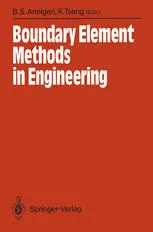Boundary Element Methods in Engineering: Proceedings of the International Symposium on Boundary Element Methods: Advances in Solid and Fluid Mechanics East Hartford, Connecticut, USA, October 2–4, 1989
3.8
Reviews from our users

You Can Ask your questions from this book's AI after Login
Each download or ask from book AI costs 2 points. To earn more free points, please visit the Points Guide Page and complete some valuable actions.Introduction to "Boundary Element Methods in Engineering"
The book "Boundary Element Methods in Engineering: Proceedings of the International Symposium on Boundary Element Methods: Advances in Solid and Fluid Mechanics" brings together a wealth of knowledge and research presented at an esteemed international symposium held from October 2–4, 1989, in East Hartford, Connecticut, USA. Edited by Dr. Balkrishna S. Annigeri and Dr. Kadin Tseng, this compilation serves as a critical resource for engineers, researchers, and academics who are engaged with boundary element methods (BEM) in solid and fluid mechanics.
By capturing the discussions, advancements, and emerging trends from leading experts in the field, the book highlights the significance and interdisciplinary applications of BEM. It offers an accessible yet in-depth examination of key methodologies and theoretical innovations, making it a cornerstone reference for understanding both the practical and theoretical aspects of boundary element analysis in engineering.
Detailed Summary of the Book
The book is an expertly curated collection of papers covering a wide range of topics in boundary element methods. Beginning with a foundational understanding of BEM, the chapters delve into both mathematical formulations and computational techniques. Readers are presented with detailed case studies and real-world applications in areas such as elasticity, fluid dynamics, heat transfer, fracture mechanics, and structural analysis.
A special focus is placed on the advances and innovations in the computational frameworks of BEM that optimize performance and accuracy. The contributors include leading researchers from around the globe who share their original insights into solving complex boundary value problems using these methods. Each paper is accompanied by rigorous discussions, equations, and methodologies to provide a comprehensive understanding to both novices and seasoned professionals.
The book’s dynamic mix of theory and application showcases its utility in solving diverse engineering problems, including those in aerospace, mechanical, and civil engineering. Coupled with this is an emphasis on the integration of BEM with other computational techniques, such as the finite element method (FEM), highlighting the versatility of boundary element approaches.
Key Takeaways
- An in-depth exploration of boundary element methods and their applications in solid and fluid mechanics.
- Detailed mathematical formulations and numerical implementation techniques tailored for real-world engineering problems.
- Valuable insights into the effective integration of BEM with other computational methods, such as FEM, for hybrid modeling solutions.
- Discussion on cutting-edge developments and research trends in the field of BEM.
- Expert contributions from globally renowned researchers and practitioners in boundary element science.
Famous Quotes from the Book
"Boundary element methods are not merely a computational tool, but a bridge that connects the elegance of mathematical theory with the complexity of real-world engineering." – A Contributor
"The power of the boundary element approach lies in its ability to reduce the dimensionality of problems, allowing for more efficient modeling of complex systems." – Dr. Balkrishna S. Annigeri
"Advancements in numerical techniques enable us to harness the true potential of boundary element methods in solving multidisciplinary problems with precision." – Dr. Kadin Tseng
Why This Book Matters
The relevance of this book transcends its publication date as boundary element methods continue to grow in importance across engineering disciplines. Its focus on addressing both applied and theoretical challenges ensures that it holds longstanding value for researchers and professionals working with complex boundary value problems. The guidance provided through rigorous case studies and practical applications ensures that this seminal text remains a highly-cited resource in the field of computational mechanics.
As boundary element techniques evolve to accommodate modern engineering challenges, this book serves as an important historical foundation for understanding their origins, growth, and practical implementations. It is not only a scientific text but a vivid reflection of a pivotal moment in engineering history when boundary element methods gained significant momentum due to rapid advancements in computational power and analytical capabilities.
Whether you are a student aiming to grasp the basics of BEM or an experienced researcher seeking to explore advanced problem-solving strategies, this book equips you with the essential tools, knowledge, and inspiration required to excel in the field of engineering.
Free Direct Download
You Can Download this book after Login
Accessing books through legal platforms and public libraries not only supports the rights of authors and publishers but also contributes to the sustainability of reading culture. Before downloading, please take a moment to consider these options.
Find this book on other platforms:
WorldCat helps you find books in libraries worldwide.
See ratings, reviews, and discussions on Goodreads.
Find and buy rare or used books on AbeBooks.
1144
بازدید3.8
امتیاز50
نظر98%
رضایتReviews:
3.8
Based on 0 users review
"کیفیت چاپ عالی بود، خیلی راضیام"


